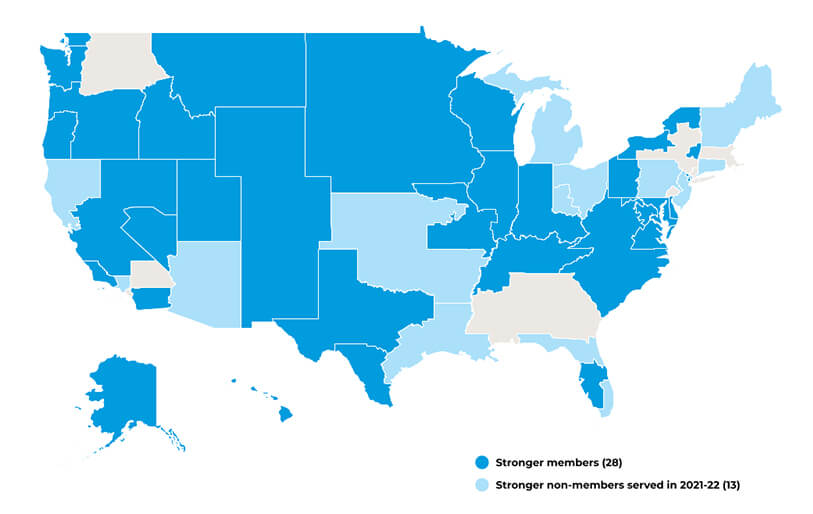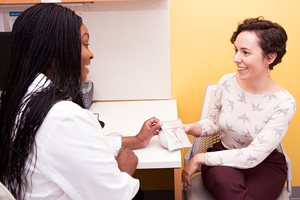Planned Parenthood
Affiliate-Led Change Makes Planned Parenthood Stronger
“We’ve never been shy about having ideas,” says Ruth Lytle-Barnaby, president and CEO of Planned Parenthood Delaware. “But there wasn’t a place or a way to elevate those ideas. We really wanted to do more cooperative sharing, not only of strengths, but also of weaknesses— to have a place to be vulnerable.”
In 2018, 33 Planned Parenthood affiliate CEOs—representing a combined $744 million in revenue— reached out to Bridgespan with an idea: What if we, affiliate CEOs, came together with a common goal to innovate together and increase access to healthcare?
Bridgespan advisory teams had already partnered with Planned Parenthood. Since 2014, six affiliates participated in Leading for Impact, and Bridgespan also worked directly with the national office. But this new engagement was fundamentally different. “Affiliates were coming together to say, we want to build a new model of innovation and collaboration, led and owned by affiliates, that puts patients and equity at the forefront and builds our resilience to weather future challenges,” says Bridgespan Partner Mark McKeag.
 Planned Parenthood affiliates can choose to be members of Stronger or to purchase services à la carte. Currently, out of 49 total Planned Parenthood affiliates, Stronger averages a membership of 28 to 30 affiliates across 36 states and Washington, D.C. In 2021–22, Stronger also provided products and services to 13 additional non-member affiliates across 19 states. Image: Planned Parenthood
Planned Parenthood affiliates can choose to be members of Stronger or to purchase services à la carte. Currently, out of 49 total Planned Parenthood affiliates, Stronger averages a membership of 28 to 30 affiliates across 36 states and Washington, D.C. In 2021–22, Stronger also provided products and services to 13 additional non-member affiliates across 19 states. Image: Planned ParenthoodAffiliates also sought a place where day-to-day initiatives would be shielded from the steady stream of political and legislative assaults on Planned Parenthood. “We needed a place where the work could move forward and not be sidelined by the latest crisis,” says Paulette McElwain, president and CEO of the Virginia League for Planned Parenthood. “One of our superpowers is responding quickly to crises, but our responsiveness can make it challenging to advance longer-term projects.”
The national office agreed to fund the initial design and development of the affiliates’ vision and provide in-kind support, including housing future staff within the national office. Ultimately, this effort would go beyond simply implementing a set of joint projects to building an underlying infrastructure to enable ongoing affiliate-led innovation. “Collaboration doesn’t just happen,” says Bridgespan Principal Derek Brine. “It needs to be structured. This was the affiliates’ effort to do just that.”
The affiliates get Stronger
5 ways Stronger is unique
- Affiliate-governed: An elected board of CEOs governs Stronger; the Chief Change Officer, Stronger’s leader, reports to elected CEOs.
- Sustainable funding model: Funding is comprised of a blend of grant funding, annual member fees, and additional payments for products and services from both members and nonmembers.
- Dedicated staff: Stronger staff are allocated solely to this work.
- Demand-driven: Affiliate leaders prioritize initiatives based on their most critical needs.
- Equity-centered: Increasing patient access to care is fundamental to all of Stronger’s work.
Bridgespan Senior Manager Mary Gamber explains, “A big piece of the work in the beginning was helping the affiliates figure out what brought them together.” Collectively, they asked: “What are our core values as a group? What do we believe in?” The affiliates decided they wanted consensus building and a platform for sharing best practices. To reflect those goals, they chose the moniker “Stronger.”
Guided by the affiliates, Bridgespan helped design a structure that would become the Stronger Change Office (SCO). The SCO would help affiliateled teams deliver high-value projects that affiliates might not be able to achieve on their own. Affiliates would govern the SCO, electing a Change Leadership Committee of nine peers to represent their interests and ensure the projects addressed their highest-priority needs. They would also pay an annual membership fee to demonstrate their commitment to the effort.
In 2019, affiliate CEOs hired Sushma Sheth Ray to be Planned Parenthood’s inaugural Stronger Chief Change Officer and leader of the SCO. With a background in social justice community organizing and strategic consulting, Sheth Ray intuited the need to both be in lockstep with affiliates and to work closely with the national office. “I wanted to make sure there wasn’t that much space between our work and the conversations and evolving strategy at the national office,” says Sheth Ray. “Having our staff housed at the national office instead of an affiliate ensures coordination and alignment.”
The affiliates identified and prioritized five initial projects for the SCO to pursue. Many of those projects, like developing sophisticated market analysis tools or a network-wide standard of excellence for healthcare, were ideas from the past; some, such as market analysis, had even been attempted but lacked the structure and resources to take hold.
When the SCO began building its market analysis capability, Lytle- Barnaby asked for her Delaware affiliate to be the pilot. “Having help determining where we put a clinic that is now seeing patients was a game changer,” she says. Purchasing market analysis outside of Planned Parenthood would have cost more time and money and wouldn’t have been as tailored to her affiliate’s unique needs.
The calm in the storm
Sheth Ray sees similarities between Stronger and corporate-sector transformation teams. But where most change teams are designed to be small and nimble, Sheth Ray understands her mission is not to change with the latest crisis, but to hold a steady course for affiliates.
That course has been complicated during Sheth Ray’s short tenure. COVID, the healthcare worker crisis, and the recent Supreme Court decision in Dobbs v. Jackson Women’s Health Organization have all posed huge challenges for Planned Parenthood affiliates. All the while, Sheth Ray has stayed true to her mission. “The affiliates hired me, not to pivot, but to stay the course on important, long-term goals that will, over time, strengthen the group of providers with a shared mission,” she says.
 As Planned Parenthood faces a steady stream of challenges—from COVID to the Supreme Court’s Dobbs v. Jackson Women’s Health Organization decision and beyond—the Stronger Change Office is helping affiliates push forward with market analysis, staffing, and other supports for their health centers. “Stronger is really helping me make good decisions in an uncertain world,” attests Paulette McElwain, president and CEO of the Virginia League for Planned Parenthood. Image: Planned Parenthood
As Planned Parenthood faces a steady stream of challenges—from COVID to the Supreme Court’s Dobbs v. Jackson Women’s Health Organization decision and beyond—the Stronger Change Office is helping affiliates push forward with market analysis, staffing, and other supports for their health centers. “Stronger is really helping me make good decisions in an uncertain world,” attests Paulette McElwain, president and CEO of the Virginia League for Planned Parenthood. Image: Planned Parenthood
What comes next?
“As a advisors, we don’t often get to help build things,” says McKeag, who sees the SCO as a new tool in Bridgespan’s toolbox for supporting affiliated networks. “We’re all proud that this wasn’t just an idea—it is a resourced entity that, more than three years later and through numerous unexpected challenges, is still operating.”
Meanwhile, the SCO is not just operating smoothly, but blowing expectations out of the water. As Lytle-Barnaby reports, “Just yesterday I got a request from an affiliate asking if we can add another initiative to our portfolio because, as they said, ‘Stronger has such a good reputation.’”
Stronger now serves 57 percent of Planned Parenthood affiliates, and the SCO has grown to 19 employees to meet affiliate demand. “We just collected our second round of membership dues from affiliates that are pretty impacted by the loss of abortion rights,” reports Sheth Ray. “Paying into the SCO is not even up for debate among them.”
Eyeing the rapidly increasing volume of requests, Anne Udall, president and CEO of Planned Parenthood Columbia Willamette, is eager to preserve Stronger’s intent. “My hope is that we continue in a model that allows consensus building owned by affiliates,” she says. But Udall also wants to revel in Stronger’s success: “It’s a rough world. Trust me, it’s nice to celebrate.”
